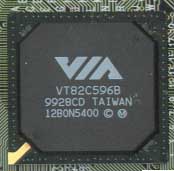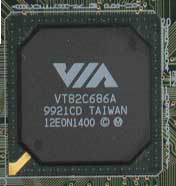Motherboard Head to Head: Epox MVP3G2 vs Tyan S1598
by Anand Lal Shimpi on September 9, 1999 10:06 PM EST- Posted in
- Motherboards
Memory/L2 Cache - Draw
Memory compatibility has been a prominent yet overlooked issue in the Super7 motherboard industry and has been the source of quite a few stability related issues, how well did our two boards stack up in the memory compatibility tests? For starters, neither board would even so much as boot with a 256MB DIMM installed in any of the three DIMM slots. We tried three different 256MB SDRAM sticks, the first featured NEC chips, the second featured Samsung and the third was a Kingston module that featured higher density NEC chips. Just like the 256MB modules, Registered DIMMs wouldn't work either, this seems like an issue dealing with the MVP3 North Bridge rather than the motherboards themselves as we have yet to see a Super7 motherboard compatible with either of those two memory types. Keep in mind that neither board supported a cacheable memory area greater than 254MB and thus the use of 256MB DIMMs wouldn't be that advantageous with either of these two boards.
Both the Epox G2 and the Tyan S1598 made use of the same 4ns Winbond L2 cache chips totaling 1MB of on-board cache. The 4ns modules, in theory, allow for operation at up to 250MHz however a number of factors obviously keep that from becoming reality (otherwise the K6-2/3 would become the ideal overclocker's platform). One of those limiting factors is the 8ns Tag RAM present on both boards which is theoretically capable of operation at frequencies up to and including 125MHz, however as we've come to know and love from the RAM industry, chip ratings are not always indicative of true limitations. The Tag RAM present on both motherboards is a 32Kx8 chip manufactured by SBT for the G2 and EliteMT for the S1598, there is no discernable difference between the two manufacturers in terms of quality.
The two boards also place their DIMM slots in identical locations and nearly equal distances away from the VIA MVP3 North Bridge controller making stability issues due to trace lengths a difficult comparison to make between the two motherboards. Overall, the memory/L2 cache comparison between the two competitors comes up as a draw.
Chipset Configuration - Advantage Epox
The versatility of the MVP3 chipset comes from VIA's North/South bridge setup, allowing for the matching up of a single North Bridge controller with different optional South Bridge chips. This remains one of the biggest differences between the Epox and the Tyan boards compared here. First let's take a look at the Epox's configuration. The G2 makes use of the VT82C598MVP North Bridge controller, Revision CE and is paired up with the VT82C596B South Bridge controller. The North Bridge chip brings the basic functionality of the MVP3 chipset to the G2 such as support for AGP 2X, SDRAM support, and other such features that are standard to all MVP3 based motherboards.
| The 596B South Bridge breaks off from the standard 596 South Bridge by adding support for the Ultra ATA 66 specification, one of the major selling points for the G2 over previous MVP3 boards manufactured by Epox. Other than that sole difference, the North/South bridge combination on the G2 is fairly standard for a MVP3 based motherboard. |
|
The Tyan board we received featured the CD revision of the VT82C598AT North Bridge, the difference between the two North Bridges will be explained a little later. This North Bridge is identical to the one featured on the Epox G2 and offers performance equal to that of the VT82C598MVP, once again, we'll explain the real differences between the two chips a little later.
| The main difference between the S1598 and the G2 is the South Bridge, with the S1598 boasting the new and more feature packed VT82C686A aka the MVP3 Super South Bridge. The 686A integrates the same Ultra ATA 66 functionality into the South Bridge however it also brings integrated hardware monitoring support, and support for a single AMR slot and thus on-board Audio/Telephony codecs, all in a chip that is pin compatible with the cheaper 596B South Bridge. |
|












0 Comments
View All Comments